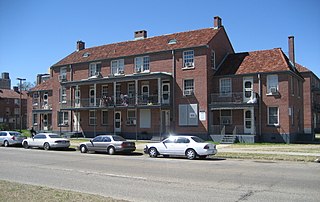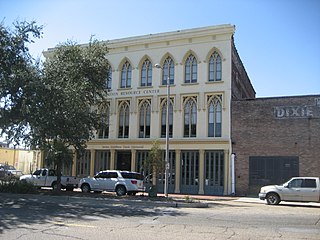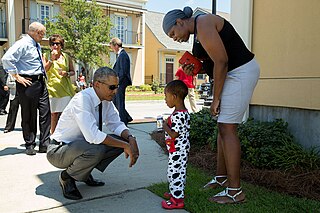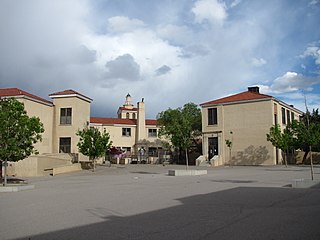
Tremé is a neighborhood in New Orleans, Louisiana. "Tremé" is often rendered as Treme, and the neighborhood is sometimes called by its more formal French name, Faubourg Tremé; it is listed in the New Orleans City Planning Districts as Tremé / Lafitte when including the Lafitte Projects.

Dillard University is a private, historically black university in New Orleans, Louisiana. Founded in 1930 and incorporating earlier institutions founded as early as 1869 after the American Civil War, it is affiliated with the United Church of Christ and the United Methodist Church.

The Garden District is a neighborhood of the city of New Orleans, Louisiana, United States. A subdistrict of the Central City/Garden District Area, its boundaries as defined by the New Orleans City Planning Commission are: St. Charles Avenue to the north, 1st Street to the east, Magazine Street to the south, and Toledano Street to the west. The National Historic Landmark district extends a little farther.

The Ninth Ward or 9th Ward is a distinctive region of New Orleans, Louisiana, which is located in the easternmost downriver portion of the city. It is geographically the largest of the 17 Wards of New Orleans. On the south, the Ninth Ward is bounded by the Mississippi River. On the western or "upriver" side, the Ninth Ward is bounded by Franklin Avenue, then Almonaster Avenue, then People's Avenue. From the north end of People's Avenue the boundary continues on a straight line north to Lake Pontchartrain; this line is the boundary between the Ninth and the city's Eighth Ward. The Lake forms the north and northeastern end of the ward. St. Bernard Parish is the boundary to the southeast, Lake Borgne farther southeast and east, and the end of Orleans Parish to the east at the Rigolets.

The Orleans Parish School Board (OPSB) governs the public school system that serves New Orleans, Louisiana. It includes the entirety of Orleans Parish, coterminous with New Orleans.

The Lower Ninth Ward is a neighborhood in the city of New Orleans, Louisiana. As the name implies, it is part of the 9th Ward of New Orleans. The Lower Ninth Ward is often thought of as the entire area within New Orleans downriver of the Industrial Canal; however, the City Planning Commission divides this area into the Lower Ninth Ward and Holy Cross neighborhoods.

The New Orleans Public Library (NOPL) is the public library service of the city of New Orleans, Louisiana, United States.

The Municipal Auditorium is a 7,853-seat multi-purpose arena in New Orleans, Louisiana, and a component of the New Orleans Cultural Center, alongside the Mahalia Jackson Theater of the Performing Arts. It is located in the Tremé neighborhood in Louis Armstrong Park adjacent to Congo Square.

Broadmoor is a neighborhood of the city of New Orleans. A subdistrict of the Uptown/Carrollton Area, its boundaries as defined by the New Orleans City Planning Commission are: Eve Street to the north, Washington Avenue and Toledano Street to the east, South Claiborne Avenue to the south, and Jefferson Avenue, South Rocheblave Street, Nashville Avenue, and Octavia Street to the west. It includes the Broadmoor Historic District which was listed on the National Register of Historic Places in 2003 and increased in its boundaries in 2007.

Phillis Wheatley High School is a secondary school located at 4801 Providence Street in Houston, Texas, United States with a ZIP code of 77020. Wheatley is a part of the Houston Independent School District. Wheatley, named after Phillis Wheatley, is located inside the 610 Loop in the Fifth Ward.

Iberville Projects was a neighborhood in the city of New Orleans and one of the low-income Housing Projects of New Orleans. The Iberville was the last of the New Deal-era public housing remaining in the city. Its boundaries were St. Louis Street, Basin Street, Iberville Street, and North Claiborne Avenue. It is located in the 6th ward of downtown New Orleans, on the former site of the Storyville district. The area has recently been redeveloped into a modernized apartment complex called the Bienville Basin Apartments.
Redeemer-Seton High School was a Catholic high school in New Orleans, Louisiana. It was permanently closed after Hurricane Katrina damaged the campus in September 2005. A formal honorary commencement ceremony was held for Katrina graduates at St. Rita's Church in New Orleans on June 25, 2006.

The Preservation Resource Center is a non-profit organization which promotes the historic preservation of buildings and architecture in New Orleans.

Charity Hospital was one of two teaching hospitals which were part of the Medical Center of Louisiana at New Orleans (MCLNO), the other being University Hospital. Three weeks after the events of Hurricane Katrina, then-Governor Kathleen Blanco said that Charity Hospital would not reopen as a functioning hospital. The Louisiana State University System, which owns the building, stated that it had no plans to reopen the hospital in its original location. It chose to incorporate Charity Hospital into the city's new medical center in the lower Mid-City neighborhood. The new hospital completed in August 2015 was named University Medical Center New Orleans.

The Tulane School of Architecture is the school of architecture at Tulane University in New Orleans, Louisiana. The school has a student body of approximately 442 students.

St. Frances Cabrini Church was a Roman Catholic parish church in New Orleans, Louisiana, from 1963 until 2005, when it was extensively damaged by floodwaters of Hurricane Katrina. The church was designed in the modernist style by New Orleans architectural firm Curtis and Davis. Their design was intended to facilitate parishioners' participation in religious ceremonies. The church building did not re-open after Hurricane Katrina and was demolished in 2007 amid controversy over architectural preservation.

The buildings and architecture of New Orleans reflect its history and multicultural heritage, from Creole cottages to historic mansions on St. Charles Avenue, from the balconies of the French Quarter to an Egyptian Revival U.S. Customs building and a rare example of a Moorish revival church.

The New Orleans African American Museum in New Orleans, Louisiana, is located in the historic Tremé neighborhood, the oldest-surviving black community in the United States. The NOAAM of Art, Culture and History seeks to educate and to preserve, interpret, and promote the contributions that people of African descent have made to the development of New Orleans and Louisiana culture, as slaves and as free people of color throughout the history of American slavery as well as during emancipation, Reconstruction, and contemporary times.

New Faubourg Lafitte is a residential development in New Orleans, Louisiana, U.S. It largely occupies the area formerly filled by the since demolished Lafitte Projects public housing.

Monte Vista Elementary School is a public elementary school in the Nob Hill neighborhood of Albuquerque, New Mexico, whose campus is listed in the New Mexico State Register of Cultural Properties and the National Register of Historic Places. It is notable as one of the city's best examples of Mediterranean Revival architecture and as the historical focal point of the surrounding neighborhood. It is a part of Albuquerque Public Schools.



















